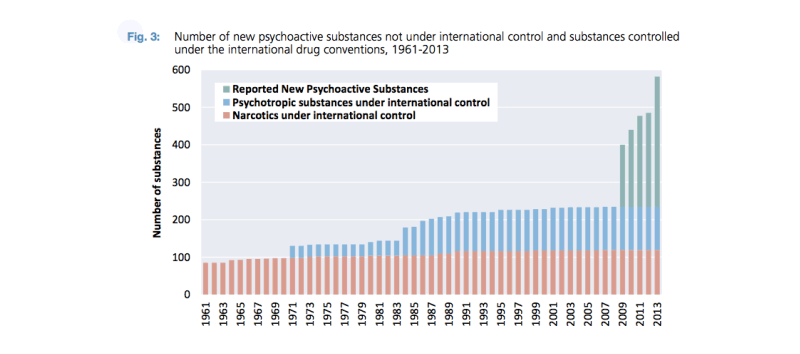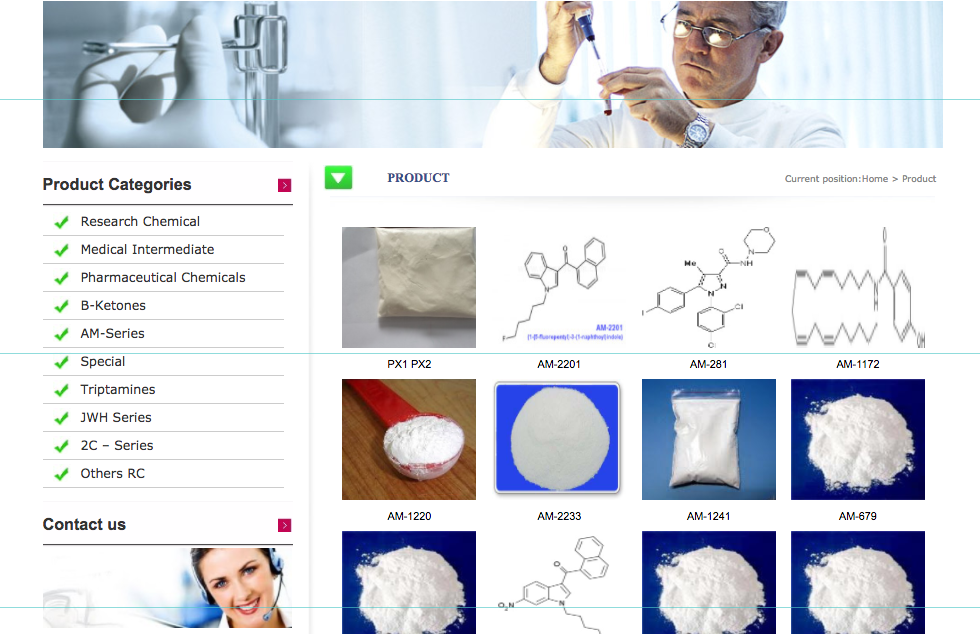In the past few months, a string of overdoses across the U.S. has been linked to an opioid drug so potent that it’s not intended for human consumption.
Carfentanil is the world’s most powerful commercial opioid, considered to be 100 times more potent than its relative fentanyl, the carefully controlled prescription painkiller linked to Prince’s death, which itself is 50 times stronger than heroin.
Originally synthesized in the 1970s, carfentanil is marketed under the name Wildnil as a general anaesthetic for large animals like elephants, and was never intended for humans. But like any number of new synthetic drugs, it’s easily finding its way from clandestine labs and into the illicit drug supply through the mail. Sold openly on the web or through drug markets on the anonymous Tor network, the drug is being added to heroin and counterfeit pain medication by traffickers and often taken by users who don’t know exactly what they’re consuming.
“We’re seeing a lot of the activity take place over the internet through anonymous relationships between a consumer and the drug manufacturer or source of supply,” says Russ Baer, a spokesman for the Drug Enforcement Administration. The agency has warned communities across the country to be on alert for the drug, and has told first responders to wear protective gloves and masks, since the drug can be dangerous to someone who simply touches it.
In recent months, hundreds of drug overdoses have been linked to carfentanil and fentanyl, a related opioid said to be 100 times the strength of morphine and commonly used to treat severe pain in cancer patients. The drug has showed up on the Gulf Coast of Florida, in western Pennsylvania, central Kentucky, and in Ohio, where, in one county this August, at least 96 heroin users overdosed in a single week.

Cursory internet searches turn up options to order the drug from Chinese sellers on numerous e-commerce websites and through dark web markets on the Tor network, where users can trade largely anonymously using bitcoin and purchase other controlled substances, from ketamine to cocaine.
Dark web vendors contacted about their supplies didn’t respond to requests for comment, and one Chinese vendor advertising carfentanil on a Korea-based e-commerce site responded only with a price quote—$300 for 200 milligrams—ignoring questions about how the product would be shipped.
Vendors often use discreet packaging for the drug. Last month Canadian border officials reported seizing one kilogram of the drug labeled as printer accessories, with agents wearing hazmat suits to handle the highly potent chemical.
The risks of the drug have also led some vendors to limit who can purchase the substance and to caution users about its dangers. In one recent listing, a vendor offering the drug pledges to only make it available to users who’ve already tried fentanyl or a related drug.
“Again, we can’t stress this enough, carfentanil is meant to be purchased by *only* experienced fentanyl users with a high tolerance,” wrote one dealer on a hidden site. “This stuff is NO JOKE.”

Another vendor, offering to ship the drug from China, warns users on safe handling instructions, which mirror those used by the veterinary industry.
“You need to wear mask and gloves to handle this chem,” the seller writes. “Accidental contact can result in OD.”
“Thousands” Of Clandestine Labs
Authorities say the drug is often shipped from China, an epicenter of synthetic chemical manufacturing and the source, according to the DEA, of the ingredients that Mexican drug traffickers use to make most of the methamphetamine consumed in the U.S. Drug officials have complained of “thousands” of clandestine labs in China, and said that despite the country’s strict drug laws, authorities there have been slow to address the problem.
“We aim to help and support other countries in any way we can,” Liu Yuejin, China’s assistant minister of public security, has said about the government’s commitment to international cooperation against drug traffickers.

Chinese officials have acknowledged that the country produces “a substantial” share of the newer synthetic drugs on the global black market and have been stepping up efforts to control the traffic. Last year the country’s courts handled nearly 140,000 drug-related cases, up 30% from 2014, according to official data. DEA officials are also in ongoing discussions with their counterparts in China about how to stem the tide of opiate imports, Baer says.
Many of the country’s illicit labs attempt to stay one step ahead of laws that ban illicit synthetic drugs simply by altering a few molecules of the chemical compound, creating new and not-yet-illegal drugs. While some countries, like the U.S., have banned whole ranges of chemicals that mimic illegal drugs, many nations have not.
Following a ban last fall of more than 115 synthetic drugs, including various analogs of fentanyl, a new, unregulated analog, furanyl fentanyl, began to appear in the U.S., according to U.S. drug officials, who subsequently moved to ban the drug stateside. At least one Chicago man died from an overdose of the drug.
“Fentanyl and fentanyl-related compounds, whether we’re speaking about fentanyl analogs such as a carfentanil, or compounds that haven’t been scheduled—for example U-47700—for the most part are originating in China,” Baer says.
Since Baer spoke to Fast Company, the DEA has announced plans to move U-47700, a powerful experimental opioid discovered in the 1970s but never approved for use in humans, into the same legal category of drugs as heroin and LSD, effectively banning it.
Legal chemicals to manufacture the drugs are also being smuggled from China into Mexico and ultimately being used to strengthen heroin or make counterfeit versions of pain pills like oxycodone, Baer says. In some cases, those precursor chemicals are stolen from licensed labs in Mexico and end up in the hands of drug traffickers.
“As far as the precursor chemicals go, you’ve got a legitimate drug manufacturing company in China shipping a precursor chemical to a legitimate chemical handler in Mexico,” says Baer. “Once they arrive in Mexico, these precursor chemicals are often then diverted to these Mexican trafficking organizations.”
Carfentanil isn’t often sold to users on its own, but rather significantly diluted and sold as heroin. One dark web listing contains a recipe for China White—a term used for potent varieties of heroin—that suggest mixing 100 milligrams of carfentanil with 100 grams of a cutting agent. Carfentanil prices on the site and elsewhere online range from $800 to about $2,500 per gram, while a report last year from the Ohio Substance Abuse Monitoring Network found heroin for sale in the Cleveland area for roughly $90 to $120 per gram, and similar prices are available through the dark web.
But if one gram of carfentanil equivalent can be used to produce the equivalent of 1,000 grams of heroin—in line with the recipe and published reports of the drug’s potency—carfentanil is still orders of magnitude cheaper per dose than heroin.
Since an equivalent dose is smaller and easier to smuggle without necessarily being much more expensive to manufacture, more potent drugs can be easier and cheaper to distribute, says Steven Kurtz, the director of Nova Southeastern University’s Center for Applied Research on Substance Abuse and Health Disparities. But, he says, retail-level dealers, let alone the rising number of people affected by what’s been called an epidemic of opioid addiction, often don’t even know what’s in a particular packet sold as heroin. Most of those who overdose on carfentanil likely don’t even know they’ve ingested it.
“It’s very lucrative,” he says. “The good thing about high potency from a distribution network standpoint is it can be shipped in very small containers, but the problem from a user standpoint is you have no idea what you’re taking.”
After a rash of deaths in Cincinnati over the Labor Day weekend, the city’s coroner said she believed that the area was being used as a “test tube” by drug dealers who were cutting carfentanil into fentanyl and heroin.

The Unknown Risk
Since the drug was until recently so rare outside of specialized veterinary practice, scientists aren’t entirely sure what the lethal human dose of the drug is—though experts have speculated it could be less than the weight of a grain of sugar. Only 19 grams of the drug were legally produced in the U.S. last year, according the DEA, though more than 50 times that amount was found in just one shipment from China seized by Canadian authorities in late June.
In 2010, the authors of a paper in the American Journal of Emergency Medicine reported what they called the first confirmed case of poisoning with the drug. They described a veterinarian who, while sedating elk for a tuberculosis test, accidentally splashed his face with carfentanil while pulling a misdirected tranquilizer dart from a tree trunk. Within two minutes, he became drowsy and had to be treated with an opioid antidote kit that’s kept on hand when the drug is used. He recovered without serious incident, according to the report.
And while the drug is increasingly available to drug traffickers and dark web buyers, it’s still hard to come by for law enforcement officials who need samples to compare against seized substances and to determine the cause of death of overdose victims.
“When we first started talking about fentanyl in July, we were unable to actually get a sample [of carfentanil] for testing, so we reached out to the zoo,” said Dr. Lakshmi Sammarco, the coroner of Ohio’s Hamilton County, which includes Cincinnati, in a Tuesday press conference. “It is a compound that is used for large animal sedation and opiate use, but we weren’t able to get any from our zoo—they didn’t have any. So we reached out to our fellow coroners in Franklin County, Summit and Cuyahoga County, and nobody had enough.”
Only by working with Senator Rob Portman and the DEA was Sammarco’s office able to obtain a sample of the drug and confirm it had killed at least eight people in the county since July. Since carfentanil is still rare, and many labs don’t yet have the ability to test for it, it’s difficult to know how many deaths are attributed to the drug. But Centers for Disease Control researchers have said fentanyl-related deaths in Ohio rose 526%, from 84 to 526, between 2013 and 2014, as synthetic opioids first began to appear in the state in large numbers.
County officials are also worried about the efficacy of naloxone, or Narcan, the opioid antidote that helps users recover from a heroin overdose. While emergency responders typically use one or two shots to counteract a heroin overdose, carfentanil can require six or even more. A spokesman for the city of Cincinnati told the local Fox affiliate that a typical Narcan dose costs about $32, a cost that’s increased in recent years from $15 a dose.
Senator Portman is part of a group of lawmakers who introduced legislation to require more digital information for packages shipped internationally in an effort to make it harder to import drugs through the mail. The Postal Service currently receives less electronic information about packages before they arrive in the U.S. than private carriers such as UPS and FedEx do, making it harder to detect suspicious shipments, he said in a statement.
“That includes information like who and where it is coming from, who it’s going to, where it is going, and what’s in it,” he said. “Having this information in advance will enable CBP to better target potential illegal packages, and that will help ensure that dangerous drugs like fentanyl and carfentanil don’t end up in the hands of drug traffickers who want to harm our local communities.”
The bill was referred to the Senate Finance Committee, though it’s unclear, assuming it passes, whether it will do much to limit the flow of synthetic drugs or simply drive smugglers to get them into the country by other means.
According to Baer, much of the carfentanil and other strong opioids causing overdoses are likely delivered through more traditional channels. In the case of Cincinnati, it’s thought that the drug is mostly coming in through heroin shipments that flow north on Interstates 71 and 75.
“Traditional smuggling methods are being used in terms of the bulk smuggling activity,” he says.
And while opioid addicts are likely increasingly aware of the dangers posed by chemicals of unpredictable potency, they’re often left with limited alternatives.
“People in communities that are using the drugs are becoming more and more aware that they can’t necessarily trust the potency of what they’re taking,” says Kurtz. “At the same time, opioid addiction is extremely powerful, so having them stop isn’t usually an option.”
Recognize your brand’s excellence by applying to this year’s Brands That Matter Awards before the early-rate deadline, May 3.
